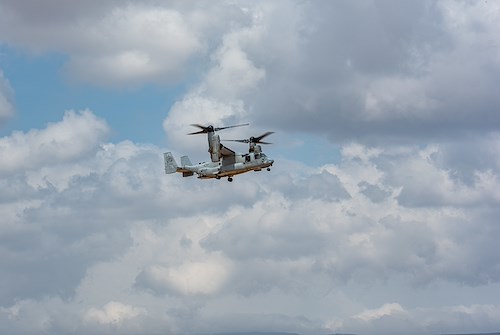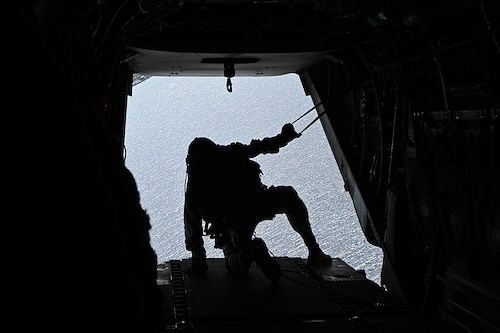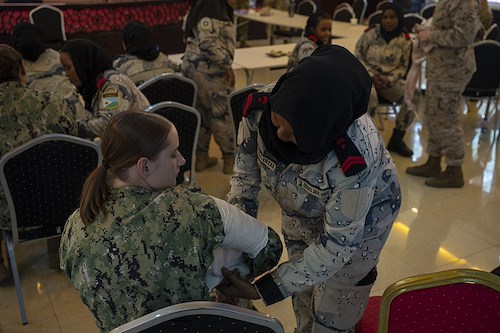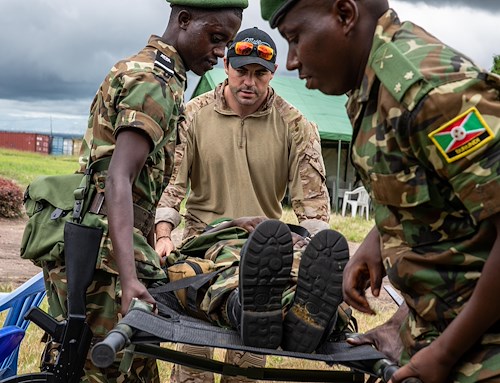Gallery contains 24 images
×
Photo 1 of 24
Combined Joint Task Force - Horn
An MV-22 Osprey with Marine Medium Tiltrotor Squadron 161 (VMM-161) flies during a U.S. Personnel Recovery Coordination Center (PRCC) validation exercise at Grand Bara, Djibouti, Oct. 31, 2021. The PRCC, in support of Combined Joint Task Force - Horn of Africa (CJTF-HOA), conducts personnel recovery and casualty evacuation for U.S. and joint partners in East Africa. CJTF-HOA conducted a full casualty evacuation exercise working through all the phases of recovery and reintegration to test their personnel recovery and casualty evacuation system for deficiencies. (U.S. Air Force photo by Senior Airman Dwane R. Young)
Photo by: Senior Airman Dwane Young
Photo 2 of 24
Combined Joint Task Force - Horn
U.S. Air Force Capt. Hans Kollar, 449th Air Expeditionary Group, chief of safety, signals an MV-22 Osprey during a U.S. Personnel Recovery Coordination Center (PRCC) validation exercise at Grand Bara, Djibouti, Oct. 31, 2021. Kollar played the role of a downed pilot during a full casualty evacuation exercise that displayed the capabilities of the PRCC and tested their personnel recovery and casualty evacuation system for deficiencies. The PRCC, in support of Combined Joint Task Force - Horn of Africa (CJTF-HOA), conducts personnel recovery and casualty evacuation for U.S. and joint partners in East Africa. (U.S. Air Force photo by Senior Airman Dwane R. Young)
Photo by: Senior Airman Dwane Young
Photo 3 of 24
Combined Joint Task Force - Horn
An MV-22 Osprey assigned to Marine Medium Tiltrotor Squadron 161 (VMM-161) prepares to land during a U.S. Personnel Recovery Coordination Center (PRCC) validation exercise at Grand Bara, Djibouti, Oct. 31, 2021. The Osprey transported U.S. Air Force Special Tactics Airmen to recover a downed pilot as part of the exercise scenario. The PRCC, in support of Combined Joint Task Force - Horn of Africa (CJTF-HOA), conducts personnel recovery and casualty evacuation for U.S. and joint partners in East Africa. CJTF-HOA conducted a full casualty evacuation exercise to display capabilities and test their personnel recovery and casualty evacuation system for deficiencies. (U.S. Air Force photo by Senior Airman Dwane R. Young)
Photo by: Senior Airman Dwane Young
Photo 4 of 24
Combined Joint Task Force - Horn
U.S. Air Force Special Tactics Airmen with the 82nd Expeditionary Rescue Squadron exit an MV-22 Osprey with Marine Medium Tiltrotor Squadron 161 (VMM-161) during a U.S. Personnel Recovery Coordination Center (PRCC) validation exercise at Grand Bara, Djibouti, Oct. 31, 2021. The PRCC, in support of Combined Joint Task Force - Horn of Africa (CJTF-HOA), conducts personnel recovery and casualty evacuation for U.S. and joint partners in East Africa. The exercise displayed PRCC’s capabilities and tested their personnel recovery and casualty evacuation system for deficiencies. (U.S. Air Force photo by Senior Airman Dwane R. Young)
Photo by: Senior Airman Dwane Young
Photo 5 of 24
Combined Joint Task Force - Horn
U.S. Air Force Special Tactics Airmen with the 82nd Expeditionary Rescue Squadron secure an MV-22 Osprey with Marine Medium Tiltrotor Squadron 161 (VMM-161) during a U.S. Personnel Recovery Coordination Center (PRCC) validation exercise at Grand Bara, Djibouti, Oct. 31, 2021. The PRCC, in support of Combined Joint Task Force - Horn of Africa (CJTF-HOA), conducts personnel recovery and casualty evacuation for U.S. and joint partners in East Africa. The exercise displayed PRCC’s capabilities and tested their personnel recovery and casualty evacuation system for deficiencies. (U.S. Air Force photo by Senior Airman Dwane R. Young)
Photo by: Senior Airman Dwane Young
Photo 6 of 24
Combined Joint Task Force - Horn
U.S. Air Force Airman Special Tactics Airmen with the 82nd Expeditionary Rescue Squadron recover a simulated downed pilot during a U.S. Personnel Recovery Coordination Center (PRCC) validation exercise at Grand Bara, Djibouti, Oct. 31, 2021. The PRCC, in support of Combined Joint Task Force - Horn of Africa (CJTF-HOA), conducts personnel recovery and casualty evacuation for U.S. and joint partners in East Africa. The exercise displayed PRCC’s capabilities and tested their personnel recovery and casualty evacuation system for deficiencies. (U.S. Air Force photo by Senior Airman Dwane R. Young)
Photo by: Senior Airman Dwane Young
Photo 7 of 24
Combined Joint Task Force - Horn
U.S. Air Force Special Tactics Airmen with the 82nd Expeditionary Rescue Squadron recover a simulated downed pilot during a U.S. Personnel Recovery Coordination Center (PRCC) validation exercise at Grand Bara, Djibouti, Oct. 31, 2021. The PRCC, in support of Combined Joint Task Force - Horn of Africa (CJTF-HOA), conducts personnel recovery and casualty evacuation for U.S. and joint partners in East Africa. The exercise displayed PRCC’s capabilities and tested their personnel recovery and casualty evacuation system for deficiencies. (U.S. Air Force photo by Senior Airman Dwane R. Young)
Photo by: Senior Airman Dwane Young
Photo 8 of 24
Combined Joint Task Force - Horn
A U.S. Marine with Marine Medium Tiltrotor Squadron 161 (VMM-161) looks out of an MV-22 Osprey during a U.S. Personnel Recovery Coordination Center (PRCC) validation exercise at Grand Bara, Djibouti, Oct. 31, 2021. The PRCC, in support of Combined Joint Task Force - Horn of Africa (CJTF-HOA), conducts personnel recovery and casualty evacuation for U.S. and joint partners in East Africa. The exercise displayed PRCC’s capabilities and tested their personnel recovery and casualty evacuation system for deficiencies. (U.S. Air Force photo by Senior Airman Dwane R. Young)
Photo by: Senior Airman Dwane Young
Photo 9 of 24
Combined Joint Task Force - Horn
U.S. Air Force Special Tactics Airmen with the 82nd Expeditionary Rescue Squadron stand in a Marine Medium Tiltrotor Squadron 161 (VMM-161), MV-22 Osprey during a U.S. Personnel Recovery Coordination Center (PRCC) validation exercise at Grand Bara, Djibouti, Oct. 31, 2021. The PRCC, in support of Combined Joint Task Force - Horn of Africa (CJTF-HOA), conducts personnel recovery and casualty evacuation for U.S. and joint partners in East Africa. The exercise displayed PRCC’s capabilities and tested their personnel recovery and casualty evacuation system for deficiencies. (U.S. Air Force photo by Senior Airman Dwane R. Young)
Photo by: Senior Airman Dwane Young
Photo 10 of 24
Combined Joint Task Force - Horn
U.S. Air Force Special Tactics Airmen assigned to the 82nd Expeditionary Rescue Squadron provide medical care to a simulated rescued pilot during a U.S. Personnel Recovery Coordination Center (PRCC) validation exercise at Grand Bara, Djibouti, Oct. 31, 2021. The PRCC, in support of Combined Joint Task Force - Horn of Africa (CJTF-HOA), conducts personnel recovery and casualty evacuation for U.S. and joint partners in East Africa. The exercise displayed PRCC’s capabilities and tested their personnel recovery and casualty evacuation system for deficiencies. (U.S. Air Force photo by Senior Airman Dwane R. Young)
Photo by: Senior Airman Dwane Young
Photo 11 of 24
Combined Joint Task Force - Horn
A U.S. Air Force Special Tactics Airman with the 82nd Expeditionary Rescue Squadron stands in a Marine Medium Tiltrotor Squadron 161 (VMM-161), MV-22 Osprey during a U.S. Personnel Recovery Coordination Center (PRCC) validation exercise at Grand Bara, Djibouti, Oct. 31, 2021. The PRCC, in support of Combined Joint Task Force - Horn of Africa (CJTF-HOA), conducts personnel recovery and casualty evacuation for U.S. and joint partners in East Africa. The exercise displayed PRCC’s capabilities and tested their personnel recovery and casualty evacuation system for deficiencies. (U.S. Air Force photo by Senior Airman Dwane R. Young)
Photo by: Senior Airman Dwane Young
Photo 12 of 24
Combined Joint Task Force - Horn
U.S. Air Force Special Tactics Airmen with the 82nd Expeditionary Rescue Squadron sit with a simulated rescued pilot in an MV-22 Osprey during a U.S. Personnel Recovery Coordination Center (PRCC) validation exercise at Grand Bara, Djibouti, Oct. 31, 2021. The PRCC, in support of Combined Joint Task Force - Horn of Africa (CJTF-HOA) conducts personnel recovery and casualty evacuation for U.S. and joint partners in East Africa. The exercise displayed PRCC’s capabilities and tested their personnel recovery and casualty evacuation system for deficiencies. (U.S. Air Force photo by Senior Airman Dwane R. Young)
Photo by: Senior Airman Dwane Young
Photo 13 of 24
Combined Joint Task Force - Horn
A U.S. Marine assigned to Marine Medium Tiltrotor Squadron 161 (VMM-161), looks out of an MV-22 Osprey during a U.S. Personnel Recovery Coordination Center (PRCC) validation exercise at Grand Bara, Djibouti, Oct. 31, 2021. The PRCC, in support of Combined Joint Task Force - Horn of Africa (CJTF-HOA), conducts personnel recovery and casualty evacuation for U.S. and joint partners in East Africa. The exercise displayed PRCC’s capabilities and tested their personnel recovery and casualty evacuation system for deficiencies. (U.S. Air Force photo by Senior Airman Dwane R. Young)
Photo by: Senior Airman Dwane Young
Photo 14 of 24
Combined Joint Task Force - Horn
U.S. service members assigned to Combined Joint Task Force - Horn of Africa (CJTF-HOA) stand in front of an MV-22 Osprey during a U.S. Personnel Recovery Coordination Center (PRCC) validation exercise at Camp Lemonnier, Djibouti, Oct. 31, 2021. The MV-22 provided transport of a simulated recovered pilot to Camp Lemonnier during the exercise. The PRCC, in support of CJTF-HOA, conducts personnel recovery and casualty evacuation for U.S. and joint partners in East Africa. The exercise displayed PRCC’s capabilities and tested their personnel recovery and casualty evacuation system for deficiencies. (U.S. Air Force photo by Senior Airman Dwane R. Young)
Photo by: Senior Airman Dwane Young
Photo 15 of 24
Combined Joint Task Force - Horn
A U.S. Marine assigned to Marine Medium Tiltrotor Squadron 161 (VMM-161) looks out of an MV-22 Osprey during a U.S. Personnel Recovery Coordination Center (PRCC) validation exercise on the flightline at Camp Lemonnier, Djibouti, Oct. 31, 2021. The PRCC, in support of Combined Joint Task Force - Horn of Africa (CJTF-HOA), conducts personnel recovery and casualty evacuation for U.S. and joint partners in East Africa. The exercise displayed PRCC’s capabilities and tested their personnel recovery and casualty evacuation system for deficiencies. (U.S. Air Force photo by Senior Airman Dwane R. Young)
Photo by: Senior Airman Dwane Young
Photo 16 of 24
Combined Joint Task Force - Horn
U.S. Air Force Special Tactics Airmen assigned to the 82nd Expeditionary Rescue Squadron directs a simulated recovered pilot to safety during a U.S. Personnel Recovery Coordination Center (PRCC) validation exercise on the flightline at Camp Lemonnier, Djibouti, Oct. 31, 2021. The PRCC, in support of Combined Joint Task Force - Horn of Africa (CJTF-HOA), conducts personnel recovery and casualty evacuation for U.S. and joint partners in East Africa. The exercise displayed PRCC capabilities and tested their personnel recovery and casualty evacuation system for deficiencies. (U.S. Air Force photo by Senior Airman Dwane R. Young)
Photo by: Senior Airman Dwane Young
Photo 17 of 24
Combined Joint Task Force - Horn
U.S. Air Force Special Tactics Airmen with the 82nd Expeditionary Rescue Squadron transfer a simulated rescued pilot to a KC-130 during the U.S. Personnel Recovery Coordination Center (PRCC) validation exercise on the flightline at Camp Lemonnier, Djibouti, Oct. 31, 2021. The PRCC, in support of Combined Joint Task Force - Horn of Africa (CJTF-HOA), conducts personnel recovery and casualty evacuation for U.S. and joint partners in East Africa. The exercise displayed PRCC’s capabilities and tested their personnel recovery and casualty evacuation system for deficiencies. (U.S. Air Force photo by Senior Airman Dwane R. Young)
Photo by: Senior Airman Dwane Young
Photo 18 of 24
Combined Joint Task Force - Horn
U.S. Marine loadmasters sit on a Marine Aerial Refueler Transport Squadron 352 (VMGR-352), KC-130J Super Hercules, during a U.S. Personnel Recovery Coordination Center (PRCC) validation exercise over Camp Lemonnier, Djibouti, Oct. 31, 2021. The PRCC, in support of Combined Joint Task Force - Horn of Africa (CJTF-HOA), conducts personnel recovery and casualty evacuation for U.S. and joint partners in East Africa. The exercise displayed PRCC’s capabilities and tested their personnel recovery and casualty evacuation system for deficiencies. (U.S. Air Force photo by Senior Airman Dwane R. Young)
Photo by: Senior Airman Dwane Young
Photo 19 of 24
Combined Joint Task Force - Horn
U.S. Marine Corps Staff Sgt. Renato Garafalo, a loadmaster with Marine Aerial Refueler Transport Squadron 352 (VMGR-352), looks through a window on a KC-130J Super Hercules during a U.S. Personnel Recovery Coordination Center (PRCC) validation exercise over Camp Lemonnier, Djibouti, Oct. 31, 2021. VMGR-352 tested the ability of PRCC assets to transfer recovered personnel overseas to higher levels of care. The PRCC, in support of Combined Joint Task Force - Horn of Africa (CJTF-HOA), conducts personnel recovery and casualty evacuation for U.S. and joint partners in East Africa. The exercise displayed PRCC capabilities and tested their personnel recovery and casualty evacuation system for deficiencies. (U.S. Air Force photo by Senior Airman Dwane R. Young)
Photo by: Senior Airman Dwane Young
Photo 20 of 24
Combined Joint Task Force - Horn
U.S. Air Force Special Tactics Airmen with 82nd Expeditionary Rescue Squadron fly with a simulated recovered pilot on a KC-130J Super Hercules with Marine Aerial Refueler Transport Squadron 352 (VMGR-352), during a U.S. Personnel Recovery Coordination Center (PRCC) validation exercise over Camp Lemonnier, Djibouti, Oct. 31, 2021. The flight simulated the ability of PRCC assets to transfer recovered personnel overseas to higher levels of care. The PRCC, in support of Combined Joint Task Force - Horn of Africa (CJTF-HOA), conducts personnel recovery and casualty evacuation for U.S. and joint partners in East Africa. The exercise displayed PRCC capabilities and tested their personnel recovery and casualty evacuation system for deficiencies. (U.S. Air Force photo by Senior Airman Dwane R. Young)
Photo by: Senior Airman Dwane Young
Photo 21 of 24
Combined Joint Task Force - Horn
A U.S. Air Force Special Tactics Airmen with the 82nd Expeditionary Rescue Squadron looks out of a window of a KC-130J Super Hercules with Marine Aerial Refueler Transport Squadron 352 (VMGR-352), during a U.S. Personnel Recovery Coordination Center (PRCC) validation exercise over Camp Lemonnier, Djibouti, Oct. 31, 2021. The KC-130J flight simulated the ability of PRCC assets to transfer recovered personnel overseas to higher levels of care. The PRCC, in support of Combined Joint Task Force - Horn of Africa (CJTF-HOA), conducts personnel recovery and casualty evacuation for U.S. and joint partners in East Africa. The exercise displayed PRCC’s capabilities and tested their personnel recovery and casualty evacuation system for deficiencies. (U.S. Air Force photo by Senior Airman Dwane R. Young)
Photo by: Senior Airman Dwane Young
Photo 22 of 24
Combined Joint Task Force - Horn
Lt. Lucy Sho, Camp Lemonnier Expeditionary Medical Facility (EMF) flight surgeon, and Lt. j.g. Katelyn Morton, EMF nurse, treats injuries of Capt. Hans Kollar, 449th Air Expeditionary Group chief of safety during a U.S. Personnel Recovery Coordination Center (PRCC) validation exercise at Camp Lemonnier, Djibouti, Oct. 31, 2021. EMF members provided higher-level medical care to Kollar who simulated a recovered downed pilot for the exercise. The PRCC, in support of Combined Joint Task Force - Horn of Africa (CJTF-HOA), conducts personnel recovery and casualty evacuation for U.S. and joint partners in East Africa. The exercise displayed PRCC’s capabilities and tested their personnel recovery and casualty evacuation system for deficiencies. (U.S. Air Force photo by Senior Airman Dwane R. Young)
Photo by: Senior Airman Dwane Young
Photo 23 of 24
Combined Joint Task Force - Horn
U.S. Personnel Recovery Coordination Center (PRCC) survival, evasion, resistance and escape (SERE) specialists conduct a debriefing for a simulated recovered pilot during a validation exercise at the Reintegration Facility at Camp Lemonnier, Djibouti, Oct. 31, 2021. Accompanied by a SERE psychologist for mental and emotional support, the recovered person is debriefed during the reintegration process to provide time sensitive information. The PRCC, in support of Combined Joint Task Force - Horn of Africa (CJTF-HOA), conducts personnel recovery and casualty evacuation for U.S. and joint partners in East Africa. The exercise displayed PRCC’s capabilities and tested their personnel recovery and casualty evacuation system for deficiencies. (U.S. Air Force photo by Senior Airman Dwane R. Young)
Photo by: Senior Airman Dwane Young
Photo 24 of 24
Combined Joint Task Force - Horn
Maj. Jeffrey Leversedge, U.S. Personnel Recovery Coordination Center (PRCC) director, takes notes during a validation exercise at the Reintegration Facility at Camp Lemonnier, Djibouti, Oct. 31, 2021. Camp Lemonnier is home to the only Phase 1 Reintegration Facility in Africa. After a recovery, rescued personnel are debriefed during the reintegration process to provide time sensitive information. The PRCC, in support of Combined Joint Task Force - Horn of Africa (CJTF-HOA), conducts personnel recovery and casualty evacuation for U.S. and joint partners in East Africa. The exercise displayed PRCC’s capabilities and tested their personnel recovery and casualty evacuation system for deficiencies. (U.S. Air Force photo by Senior Airman Dwane R. Young)
Photo by: Senior Airman Dwane Young
With a sprained left ankle, fractured collarbone and burns to his forearm, the U.S. Air Force pilot finally makes it to his feet.
He’s alone and isolated in the middle of Africa with nothing within sight except the rubble of his downed aircraft.
Now what?
These are the moments; the U.S. Personnel Recovery Coordination Center (PRCC) train for, and a similar training scenario was presented to them on Oct. 31, 2021.
The PRCC at Camp Lemonnier, Djibouti, in support of Combined Joint Task Force - Horn of Africa (CJTF-HOA), conducts personnel recovery and casualty evacuation for U.S. and joint partners in East Africa.
The minute someone becomes isolated and the PRCC is alerted, an invisible timer goes off, because in personnel recovery and casualty evacuation, the quicker the response, the better odds of survival.
To test that response time and demonstrate their capabilities, the PRCC conducted a full casualty evacuation exercise from start to finish. More importantly, the exercise served to examine their system for deficiencies.
With the consistent operations tempo of U.S., partner and allied forces in East Africa, PRCC members can be called into action at any moment.
“Real world emergencies happen suddenly, often without notice, so we build those types of scenarios into our training,” said Maj. Jeffrey Leversedge, PRCC director and exercise planner.
To simulate that urgency, Leversedge and exercise planners provided minimal information to the exercise participants.
“Participants were informed we were having an exercise, and given required safety information; that’s it,” said Tech. Sgt. Mark Mitchell, a PRCC survival, evasion, resistance and escape (SERE) specialist and exercise planner. “We wanted the players to have to work through problems and roadblocks in real-time.”
Personnel recovery and casualty evacuation in East Africa is a massive endeavor. It relies on the partnership of multiple countries, U.S. government agencies and military personnel from all sister services to execute.
“The sheer size of the area of responsibility for CJTF-HOA is one of our biggest challenges,” Leversedge said. “So comprehensive exercises like this are a necessity.”
The size and scope of support provided by PRCC means the missions themselves are incredibly complex. They involve multiple teams and numerous moving parts that must come together for the mission to succeed.
For example, while an MV-22 Osprey transported the pararescuemen to make initial contact and begin the recovery, a KC-130J Super Hercules with full crew and SERE psychologists waited on the flight line for possible transfer to higher level emergency care abroad.
At that very same time, Camp Lemonnier Expeditionary Medical Facility staff members and SERE specialists waited to receive the patient for higher level care, debriefing and to complete the reintegration process.
“Our job is to provide options and contingencies to isolated personnel and people in distress,” Mitchell said. “We cannot predict the situation or variables of our missions, so we try to remain flexible and have plans A through Z available if necessary.”
When isolated, adapting to surroundings and overcoming challenges directly impacts survival. Similarly, during a PRCC mission, how teams adapt and communicate determines success or failure.
“Each team has different lingo, different languages, different processes,” said U.S. Lt. Cmdr. Michael Connor, CJTF-HOA SERE psychologist. “These experiences and exercises are how we iron out those seams; it gets us all on the same page, speaking the same language.”
Recently, Marine Medium Tiltrotor Squadron 161 and their MV-22 Ospreys arrived at Camp Lemonnier to support CJTF-HOA operations. The Oct. 31 exercise was an important first step necessary for full integration.
“Operations at Camp Lemonnier as a deployed location are always moving and evolving,” Mitchell said. “New units are constantly departing and arriving, which can sometimes leave continuity gaps. The PRCC bridges those gaps with our training.”
The U.S. and joint partners work every day to counter violent extremists and foster security and stability in East Africa. CJTF-HOA’s PRCC makes sure those service members are never truly on their own.








